Journal Writing for Intelligent People – The Ultimate Guide
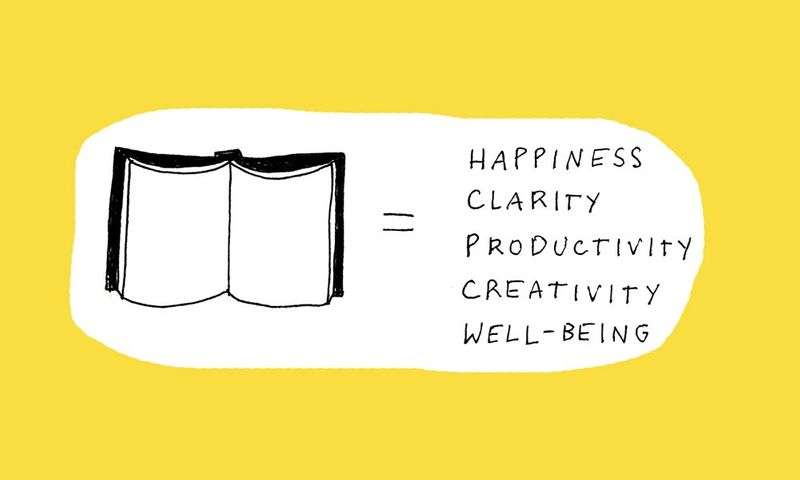
There are thousands of different ways to journal, but if you want this practice to radically improve your life, you need to do it in a way that is right for you.
That’s what I call intelligent journal writing: when you adapt your practice to meet your unique needs and personality, journaling becomes effective, intuitive, and effortless.
So how does one journal intelligently?
Mastering the art of journal writing is the same as mastering any other skill: the most effective way to do it is to understand how it works on a fundamental level, avoid common pitfalls, and learn from the masters. There’s a good reason why books such as Tribe of Mentors by Tim Ferriss are bestsellers and why mental models are so effective.
Once you have the knowledge, you’re ready to choose a strategy that is optimal for you.
With that in mind, this article will show you some powerful journaling examples and principles, and then help you design a journaling practice that is perfectly in tune with who you are and what you need.
Ready? Let’s dive in.
Intelligent Journal Writing: How It Works

The quality of your life is directly connected to the questions you are willing to ask.
Better questions lead to better answers. Better answers lead to better actions. Better actions lead to better outcomes (Ask Better Questions by Team Tony Robbins).
Your journal is a great to help you put that to practice.
Journaling is like a regular Q&A with yourself where you use cues to unlock insights and trigger specific behaviours. These cues can be questions, images, or daily actions, and their sole function is to prompt you to take effective action.
For example:
- When I see a question in my journal, I will reflect on the answer.
- When I see my habit tracker, I will track my performance.
- When I wake up, I will write in my journal for ten minutes.
In a nutshell, journaling is a simple script: When {cue}, I will {action}.
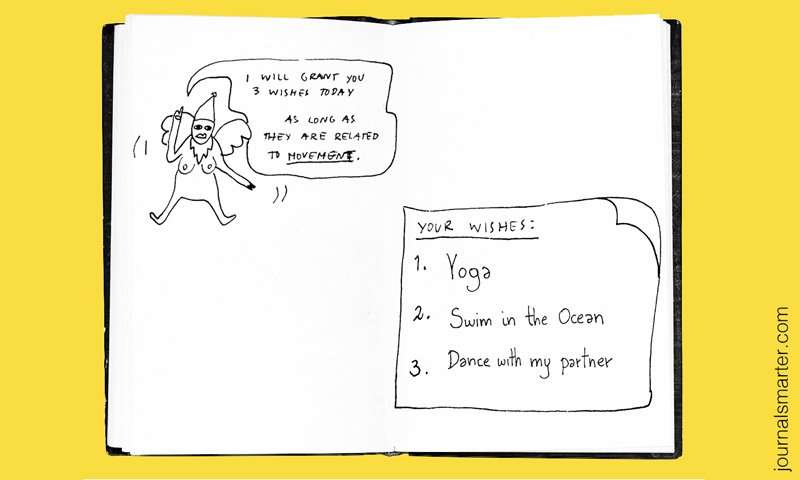
Do you see what this means?
Your journal allows you to shape your life at will in any way you desire. All you need to do is to create intelligent cues.
How?
Let’s start with how not to do it by avoiding two common pitfalls: lack of consistency, and not going deep enough.
Common Journaling Pitfall #1: Lack of Consistency
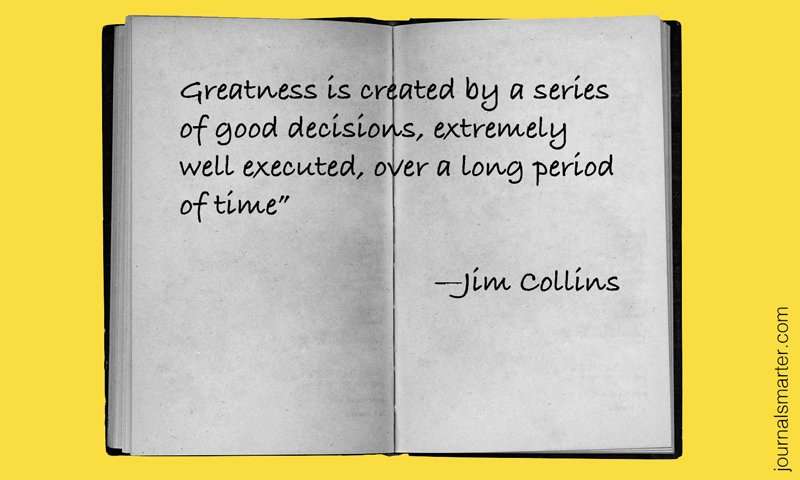
Unless you make journaling a habit, you are unlikely to feel its benefits.
It’s actually quite funny: we all know that consistency is crucial, yet that’s where most of us fail (starting with me).
So how to make journaling a daily habit, even if you totally suck at habit building?
The short answer is to start simple.
In other words: don’t overcomplicate or overcommit. If all you have is five daily minutes, don’t commit to writing twenty pages of finished prose while also filling in your daily spread, evening reflection, and tomorrow’s to-do lists.
Instead, stick with the few essential things that you need. Keeping it simple (at least in the beginning) will make your journaling practice:
- Effective—seeing quick results will keep you motivated;
- Intuitive—less clutter will give your mind more freedom;
- Effortless—less resistance will make the habit more appealing.
In a moment, we’ll dive into some simple yet powerful journaling exercises you can use.
But for now, let’s address the second journaling pitfall:
Common Journaling Pitfall #2: Not Going Deep Enough
Consistency alone is not enough.
In order to harness the full potential of your journaling practice, you need to journal in a way that engages both your conscious and your subconscious mind.
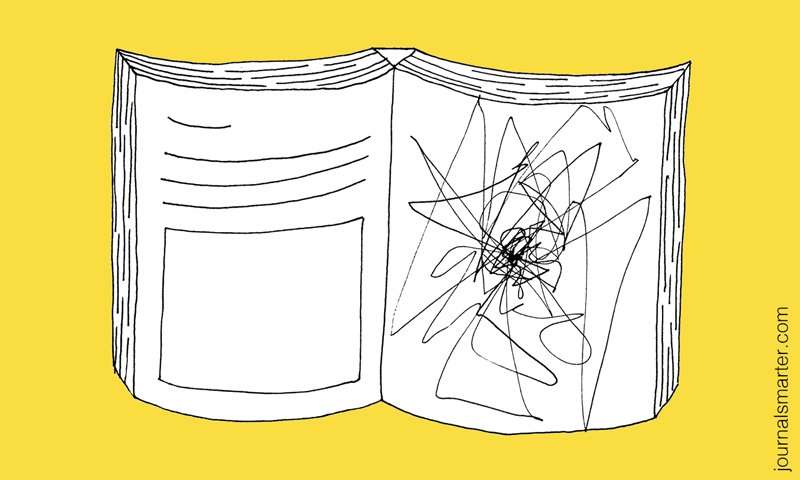
Let’s imagine you decide to build the habit of exercising every day for thirty minutes.
Tracking your workouts in your habit tracker is a great way to create accountability, and it’s a great start to build consistency.
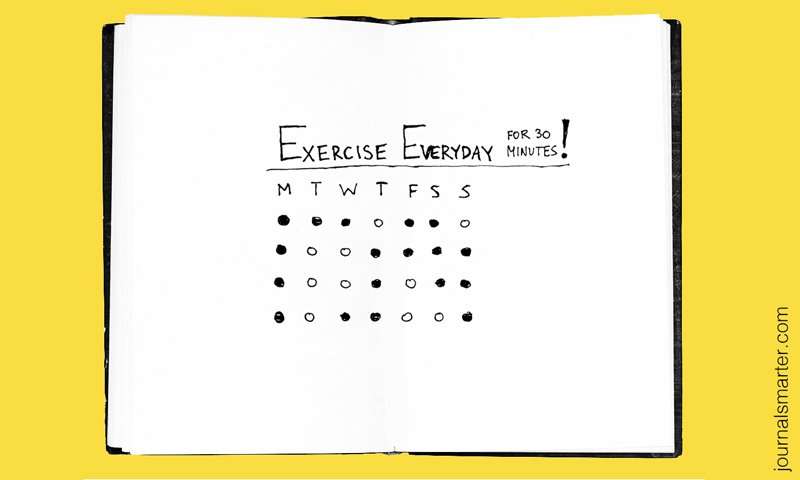
However, when obstacles surface (getting distracted, losing motivation, feeling confused), you need to shift your focus to look for the root of your problems, and find solutions.
In this specific example, this could mean cuing your subconscious to look for less obvious information with questions such as:
- Why do you want to exercise in the first place
- How do you feel before/during/after workouts?
- What keeps you from doing it?
- What kind of exercise feels the most effortless for you to do?
This exercise can bring you the clarity you need to solve problems you didn’t even know existed.
You might realize that going to sleep at 2 am is a sure way not to exercise the following day. Or maybe you’ll notice that exercising makes you feel confident and absolutely unstoppable, and your motivation spikes. Perhaps, as you look through your week, you’ll notice that calisthenic exercise feels too aggressive on your body and you’d rather do yoga instead.
Directed prompts engage your conscious mind to work with information you already have (such as tracking the type and duration of your workouts).
Indirect prompts allow you to search your subconscious mind for the root of your problems, and find solutions to solve them (such as asking questions about things that are holding you back).
Based on your insights, you can tweak your exercise plan, and then watch with pride how you progress and overcome your own expectations.
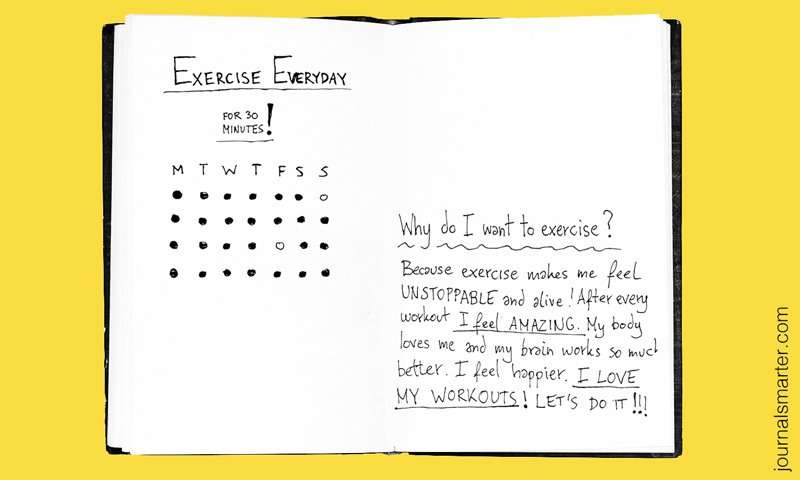
Not only can you engage your subconscious mind to unlock hidden information, but you can also use your conscious mind to turn that information into practical solutions.
Here’s a second example:
Let’s imagine that you have been feeling demotivated for a while.
You decide to start digging up your worries from the depths of your subconscious and into the light of your conscious awareness by writing them down first thing in the morning.
This is a great way to get some relief and clarity, but you can take it a step further by consciously reviewing that information, looking for relevant patterns, and devising strategies to address them.
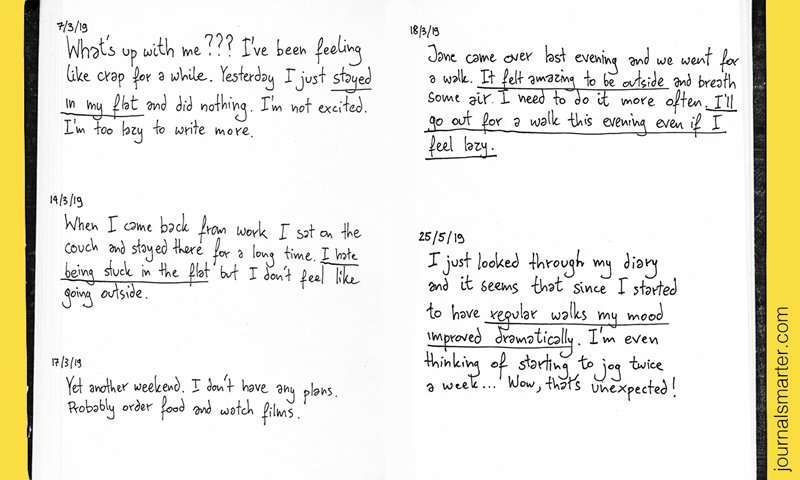
Perhaps you might notice that you always feel sad in the evenings, and you need to design a new evening routine, or make a list of things you feel grateful for.
Maybe you’ll notice how conversations with your father always trigger anxiety that lasts for a few days—and you might want to redesign your family time, write your father a letter, or create mechanisms to help you better process your emotions.
Remember:
The better you know yourself, the better cues you can create, and consequently—the better your results will be. In order for that to happen, you might need to go deeper than just doodling and writing down to-do lists in your journal—you need to fully embrace the depths of the full spectrum of your consciousness.
And if that sounds complicated, don’t worry: the steps we’re about to explore will keep the basics covered.
4 Principles From the Journals of the Brightest Minds Throughout History

Journaling has been around for over 2000 years (to learn more about the history of journaling, read those two articles: The Astonishing History of Journaling by Michele Swensen and History of Journaling published on Inbreathe.
That is why, instead of reinventing the wheel for the sake of it, we can look at how some of the most incredible people in history used their journals, and piggyback on their lessons and tips.
Without further ado, allow me to introduce you to four journaling mentors and the principles that they applied to make their journaling writing powerful and effective. I hope you’ll be as inspired by them as I was—and revolutionize the way you put your thoughts and life to paper.
Leonardo DaVinci: Let Your Mind Flow
 The Codex Leicester by Leonardo Da Vinci. Source: Wikipedia.
The Codex Leicester by Leonardo Da Vinci. Source: Wikipedia.
Leonardo didn’t care much for structure.
One idea sparked another, and Da Vinci kept on jumping freely between them in an unrestricted creative flow.
As a result, his journals combine an impressive number of inventions, designs, observations and discoveries (eg. a helicopter and a full dissection of human anatomy) Here’s a list of some of Da Vinci’s inventions. And that was five hundred years ago!
Here’s the video compressing the magic of Leonardo’s journals into one minute.
What can we learn from this?
Da Vinci’s mind was brilliant.
And so is yours.
Therefore never stop yourself from journaling whatever is on your mind and in whichever way you feel like.
Think of it as a blank canvas for unrestricted flow of your mind. It doesn’t have to be linear. It doesn’t have to be text. And even if it is, it doesn’t have to be horizontal.
 The Codex Arundel by Leonardo Da Vinci. Source: kottke.org.
The Codex Arundel by Leonardo Da Vinci. Source: kottke.org.
You can doodle even if your drawing skills are embarrassing. You can tear paper off. You can write backward, or not write at all and instead draw what’s on your mind. The key is to give yourself permission to experiment.
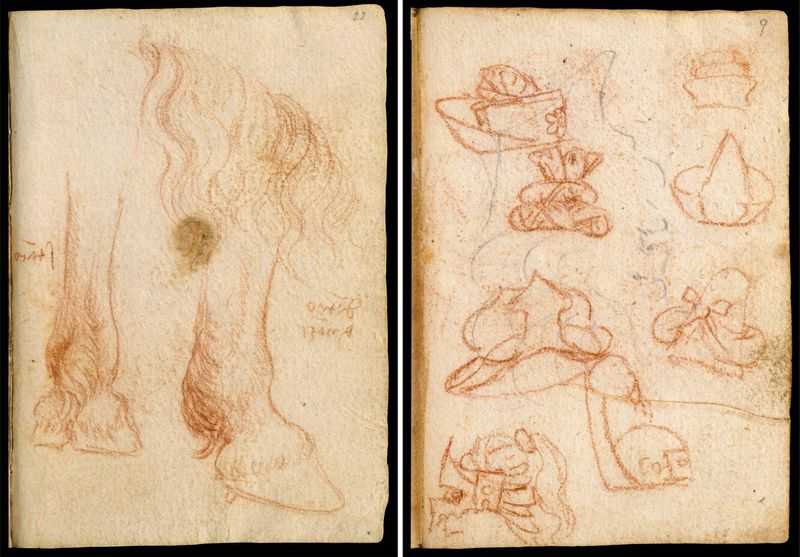 The Codex Leicester by Leonardo Da Vinci. Source: V&A.
The Codex Leicester by Leonardo Da Vinci. Source: V&A.
Remember:
You can’t journal wrong.
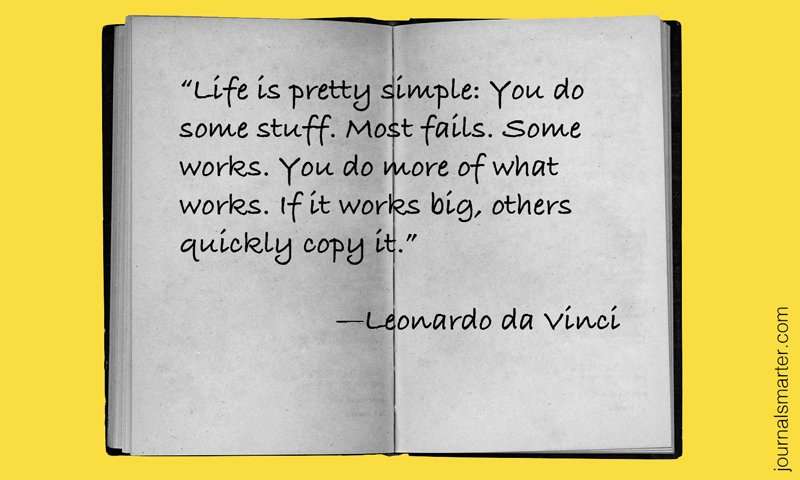
The more intuitive journaling is for you, the more pleasant it will be, which in turn will make you more consistent, which will help you make it even more intuitive.
And who knows?
Your brain might even spark some incredible ideas in the process.
Note: I highly recommend looking through Da Vinci’s journals. You can access the scans for free on this website, and here’s the transcript in English.
Frida Kahlo: Paper Will Take Anything
 Frida’s diary. Source: hagitaz.
Frida’s diary. Source: hagitaz.
If you ever feared to face what might come out of your head when you journal, think about Frida Kahlo.
From an early age, her life consisted of pretty much constant suffering, physical and emotional, which was reflected in her unique and powerful art.
And she wasn’t afraid to put it on paper.
Frida covered her journal with drawings and writings expressing her suffering, pouring all of her feelings onto its pages without any restrictions whatsoever. Have A Peek at Frida Kahlo’s Diary, published by Museo Dolores Olmedo.
Here’s how it looks like:
Why did she do that?
For one simple reason:
Cathartic release.
Channeling your feelings, thoughts and realizations, no matter how painful and/or embarrassing is a powerful healing process that leads to purification This article by Amber Lea Starfire explains more about the cathartic release. The entry on Wikipedia is also good to look at.
It’s like sharing your deepest worries with your closest and most trusted friend. No matter how difficult it might be, the act of “venting” will make you feel lighter.
 Frida’s diary. Source: hagitaz.[/caption]
Frida’s diary. Source: hagitaz.[/caption]
Bottom line:
Paper will take anything. Use it to share your burdens.
Note: If you feel like digging deeper, have a look at Frida’s diaries and/or her handwritten letters.
Benjamin Franklin: Systems Beat Willpower
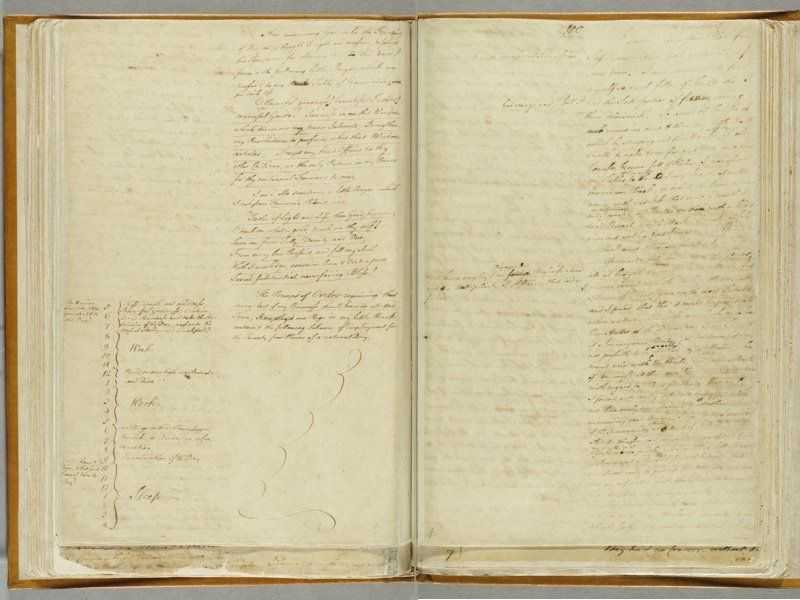 Benjamin Franklin’s Autobiography with his daily routine on the bottom left. Source: University of Pennsylvania Libraries.
Benjamin Franklin’s Autobiography with his daily routine on the bottom left. Source: University of Pennsylvania Libraries.
Here’s a hard truth:
No matter how desirable your goal is, your motivation won’t last forever. To keep moving forward, you need to accommodate for your bad days and low instincts.
The best way to do that is by putting in place effective routines and systems.
And guess who’s going to be your best ally for that? You guessed right: your journal.
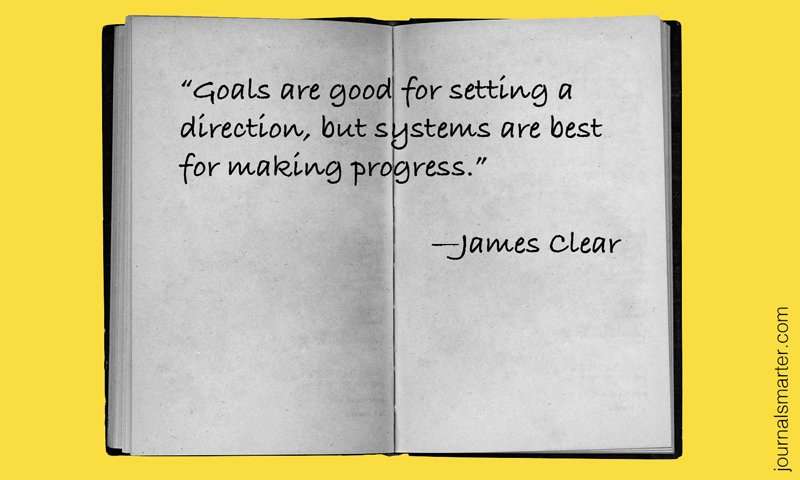
Benjamin Franklin had an ambitious life goal: the attainment of moral perfection.
To make sure he kept progressing towards his goal, he followed a simple two-step journaling routine:
- Each morning, he’d answer one question in his journal: What good will I do today? And then, in the evening, he’d reflect and check whether he did it, or not.
- Each evening, he’d track whether he violated any of the thirteen virtues he defined for himself. Benjamin Franklin’s 13 Virtues: temperance, silence, order, resolution, frugality, industry, sincerity, justice, moderation, cleanliness, tranquility, chastity and humility. Read more: Lessons In Manliness: Benjamin Franklin’s Pursuit of the Virtuous Life by Brett and Kate McKay.
Have a look at Franklin’s daily routine; it’s quite impressive:
This doesn’t mean you need to obsess about structuring every aspect of your life. However, you can definitely make it easier for yourself to reach your goals by creating a simple, stable, and effective journaling system.
Remember:
It’s not about achieving perfection. It’s about giving it your best shot every single day.
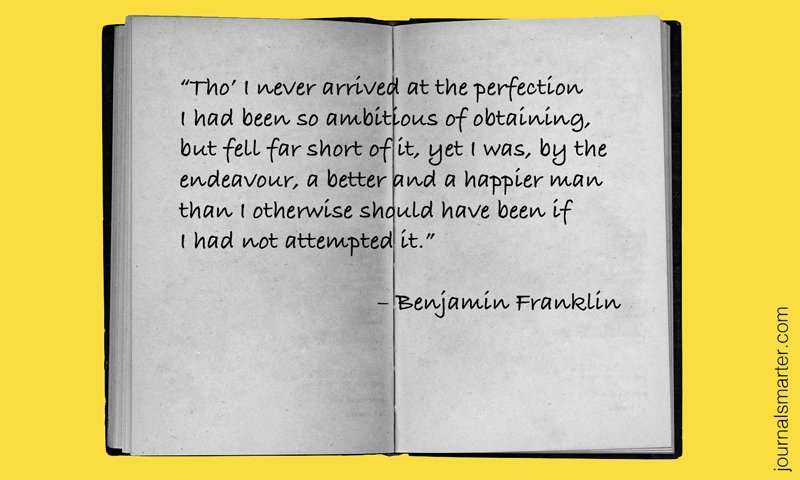
Note: You might want to read Benjamin Franklin’s autobiography. The way he went about his life is truly remarkable.
Marcus Aurelius: Ask Big Questions and Dive Deep
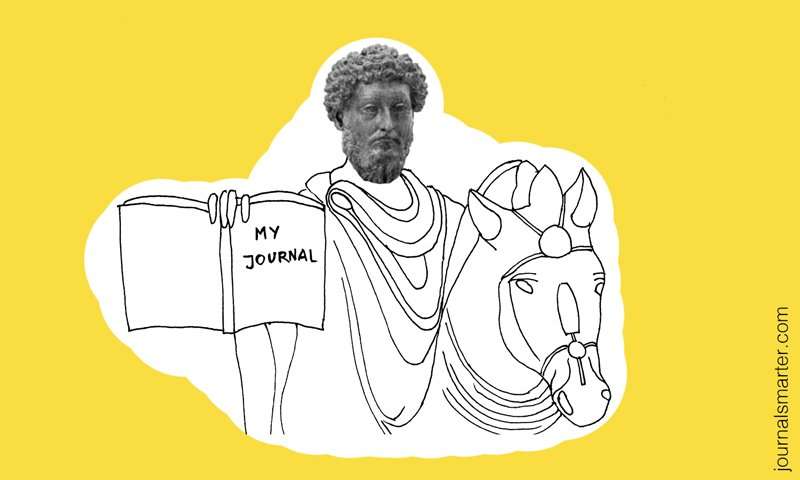
Let’s rewind a little bit.
As we discussed before, the quality of your life is directly connected to the quality of the questions you ask.
To illustrate:
Pondering the weather, traffic or some random Instagram post is unlikely to bring you any life-changing insights.
On the other hand, reflecting on your biggest flaws or what makes you feel really alive might significantly expand your understanding of yourself. You can then act upon this knowledge and improve your life.
The key is to go deep by asking important questions.

Marcus Aurelius, the emperor of Rome and the most powerful man of his time kept a journal in which he reflected on the deepest questions and problems he was facing.
The record of his thoughts, later on published as “Meditations”, remains one of the most influential philosophy books of all times, including practical life advice still relevant almost 2000 years after it was written. Here’s a great article about Meditations by Ryan Holiday.
Here’s a short video summary, exploring some of the ideas from his journal:
Here’s the deal:
Whenever you feel stuck, either with your life or your journaling practice, simply ask a big question and reflect on it. Chances are you might learn something about yourself that will literally change everything.
If you could use some inspiration, here’s a list of some of my favourite questions.
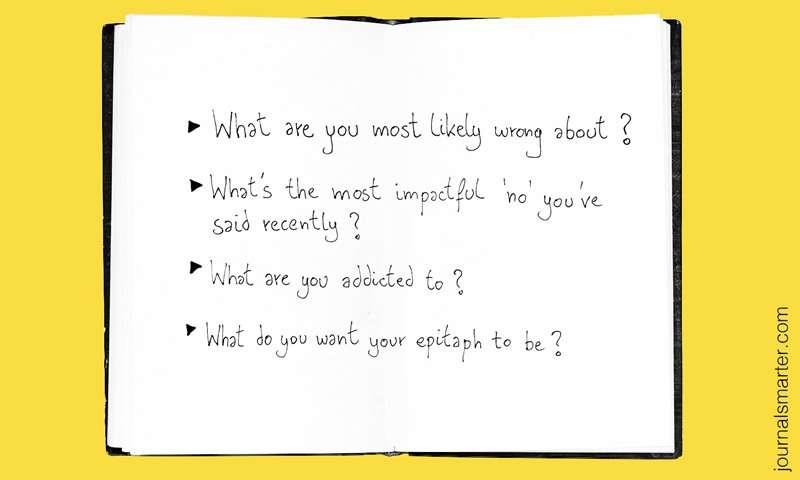
Let’s sum up what we’ve learned from these four journaling geniuses of the past:
- Let your mind flow: There’s no wrong way to journal. Allow yourself to flow freely to spark new ideas and insights.
- Paper will take anything: Share your burdens with your journal for cathartic release. You will feel lighter.
- Systems beat willpower: Motivation doesn’t last forever. Make it easier for yourself by creating systems and routines that will keep you on track.
- Ask big questions and dive deep.
Once you’ve internalized those four principles, you’re ready for the next step: creating your own journaling routine.
6 Journaling Tools to Start With (And Why They’re More Than Enough)
Just like the process of building a house, your journaling practice will be much more effective if you use the right set of tools.
Think about it:
Chainsaws are great for cutting wood, but not so much for putting nails in the wall or measuring distances.
While there is a great number of journaling exercises and methodologies you can play with, the truth is you won’t have time for all of them. That’s why I suggest starting with up to three tools that feel the most in tune with you.
And if you ever feel like scaling up—you can always add more.

With that in mind, I’ll show you my six favorite journaling tools, which you can use for:
- getting valuable insights,
- setting goals and staying on track,
- mapping out your life journey,
- accessing your subconscious,
- bringing more play to your journaling practice,
- unlocking yourself whenever you feel stuck.
Feel free to adapt the following tools in any way to suit you. And if you feel like you could use some more, just check out the resources at the end of this article.
Morning Pages
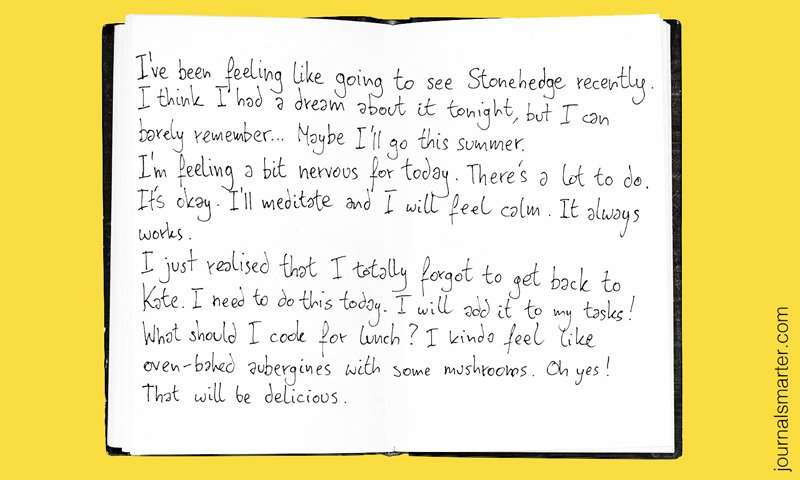
Purpose
“Morning Pages provoke, clarify, comfort, cajole, prioritize and synchronize the day at hand.” – Julia Cameron (creator of Morning Pages).
Time Required
15-30 minutes every day.
Instructions
Write three pages of longhand, stream of consciousness writing, first thing in the morning.
Note: feel free to pick a different target, such as twenty minutes or two pages.
Here’s a short overview of the process:
Learn more about Morning Pages on Julia Cameron’s website.
The 5-Bullet-Log
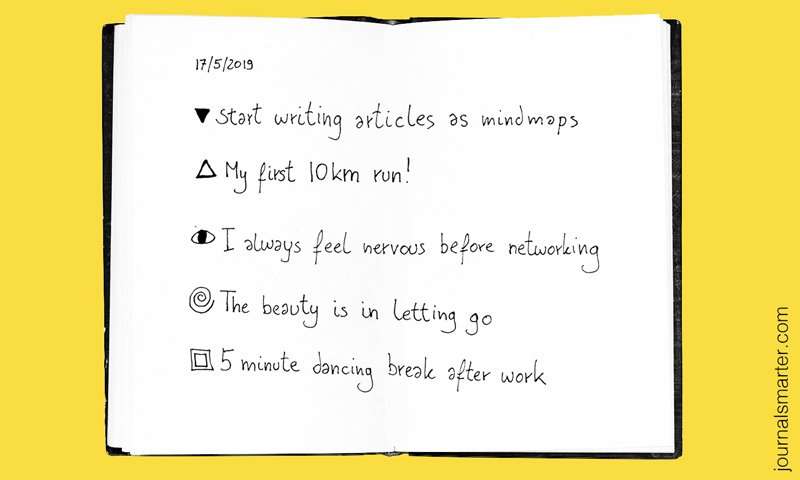
Purpose
Increase self-awareness and learn more from life.
Time Required
5-10 minutes every day.
Instructions
Every day in the evening, write down (up to) five concise answers to the following question:
What could I write about today that my future self would benefit from reading?
Here are some ideas of what to track:
- Creative ideas
- Big wins
- Cues and signs
- Big lessons and questions
- Actions and experiments
Learn more about how to set up your own 5-bullet-log in this amazing article by Silvia Bastos: The 5-Bullet-Log: A Note-Taking System to Increase Self-Awareness and Learn More From Life, or listen to the podcast where she explains how it works.
Infinity Squares (aka Minimalist Journaling System)
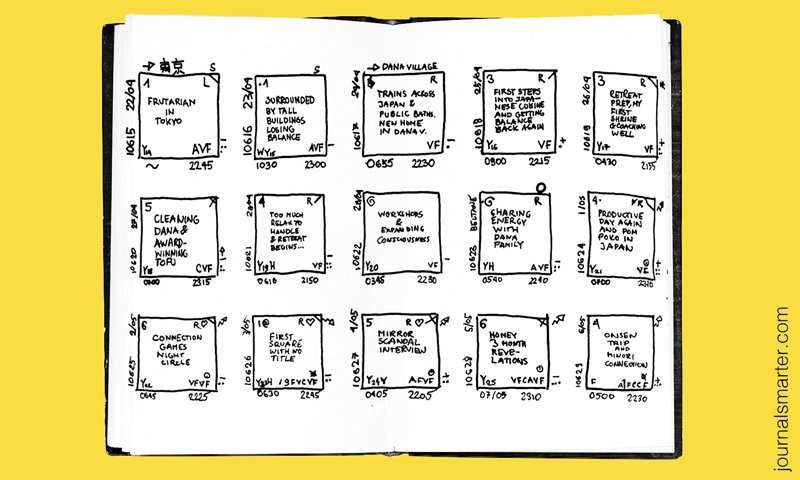
Purpose
Get an overview of your life and build habits that last.
Time Required
5 minutes every day.
Instructions
Start with drawing a page full of squares (eg. 30). Each square represents one day of your life.
Then answer the following question:
What is the one habit that I can start doing tomorrow, that would be the most effective first step towards my goal?
The last thing to do is to pick a symbol for that habit and start tracking it every day.
You can easily scale it up to track numerous habits, but also your mood, health, productivity as well as non-quantifiable data, such as your daily memory (what would I like to remember from today?). All within a clean and simple minimalist interface.
The benefit?
You can see your life at a glance.
Here is an example of how to use the Infinity Squares:
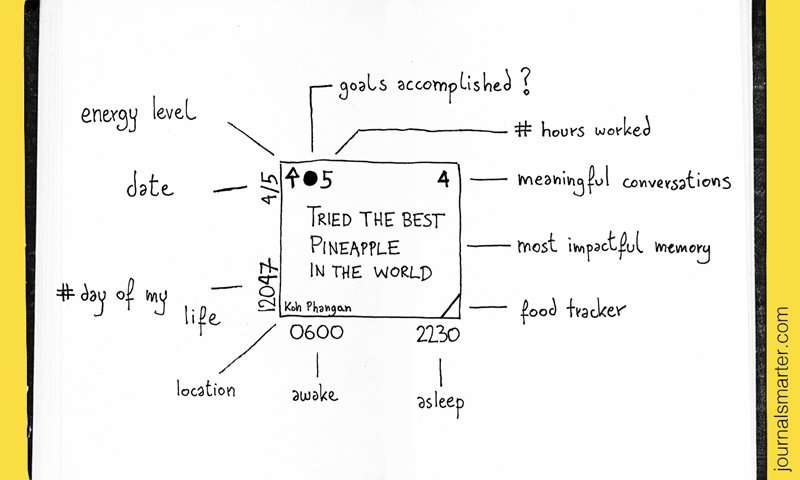
And here’s the Starter Kit if you want to give it a go.
Alternatively, read more about it in my article Minimalist Journaling: A Fun and Effective Tool for Tremendous Habit Change.
Focus Funnel
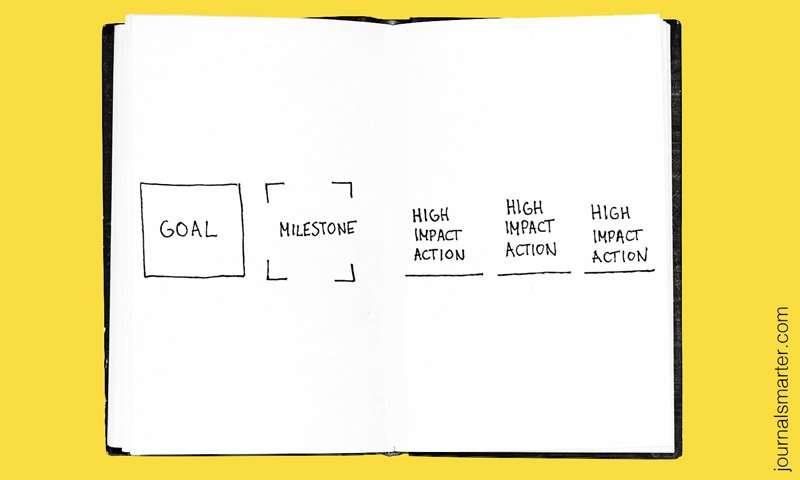
Purpose
Get what matters done every time.
Time Required
15 minutes every week.
Instructions
Every week, define your goal (or goals—although, remember that often less is more!) and the milestone you are working towards.
Note: Milestones are useful to break down a huge goal (eg. building a $1M business, write a book) into smaller, actionable chunks. For smaller goals, you might disregard milestones. Do whatever feels more intuitive.
Then, write down up to three High Impact Actions. They should be:
- 100% within your control (something you can actually do);
- Habitual (actions you can do every day);
- Highly predictive of your success (that is, if you do those things, you are most likely to achieve your goal/milestone).
Here’s the most important part:
Make sure you revisit your Focus Funnel regularly (eg. before starting to work and when scheduling your next day), to make sure that you know exactly what to do and why you are doing it.
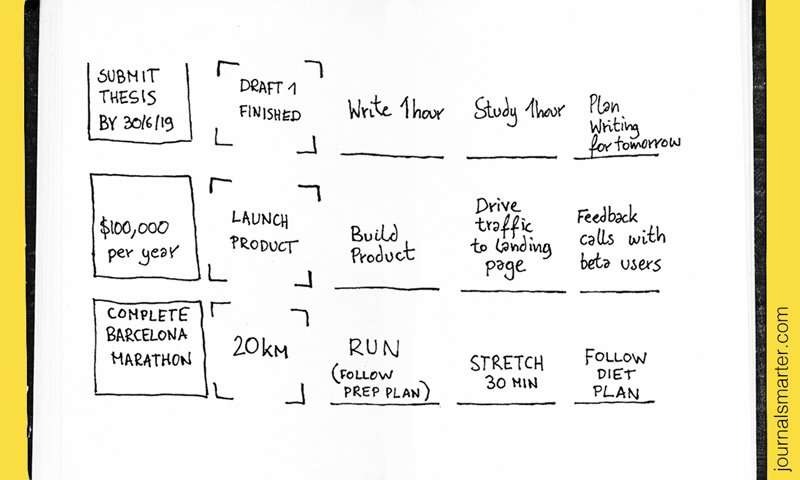
Remember: if you’re engaging in something that is not your High Impact Action, then you are likely procrastinating.
This system works extremely well together with the Minimalist Journaling System. Here’s an article I wrote on how to combine the two and beat procrastination forever.
Turn the Journal

Purpose
Add a creative boost to your journal, even if you’re not creative at all.
Time Required
1 second.
Instructions
Whenever you feel like it, turn your journal and keep on writing.
Don’t get me wrong: horizontal writing is just fine; however, you might be surprised how much what you write will change when you change how you write.
Give it a try!
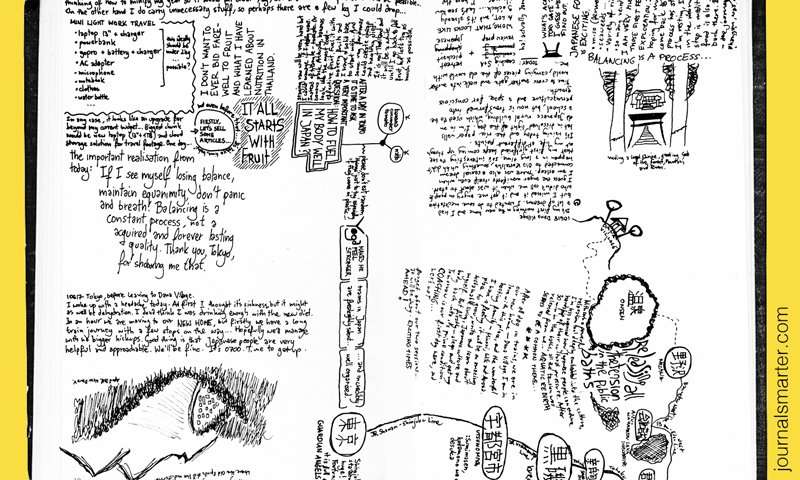
Note: You might also want to experiment with writing in circles, playing with colors, writing backward, or anything else that you come up with.
Journaling Prompts
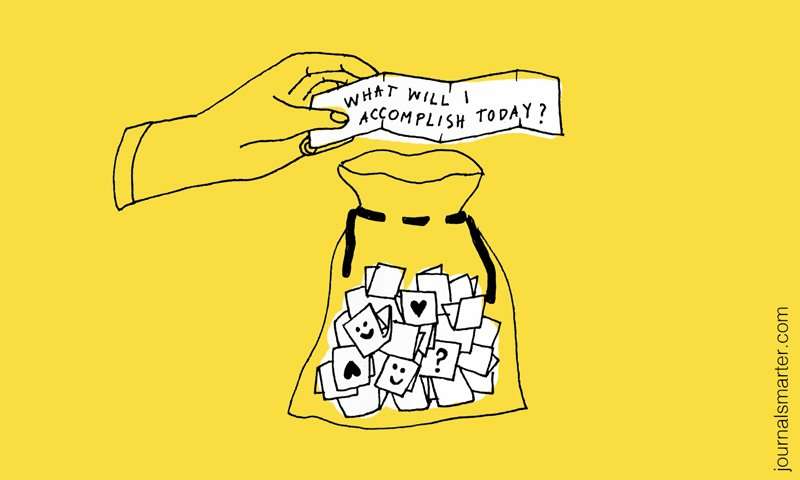
Purpose
Get valuable insights every day.
Time Required
5-10 minutes every day.
Instructions
Pick a journaling prompt and reflect on it.
It can be a question, a drawing to complete, a quote to reflect upon, a memory from your life to think about… Anything goes.
You can find them online, or create your own, and then either pick one at random or select one that feels right.
Implement Your Strategy and Start Journaling
So, how can you turn everything you just read into an actionable journaling process that will actually happen and bring you results?
It’s quite simple: avoid the pitfalls (be consistent and go deep); keep in mind the teachings from the masters; and pick your favorite journaling tools (again—to start, I recommend up to three).
Then, all you need to do is make journaling a part of your routine, and keep perfecting your practice.
Here’s how:
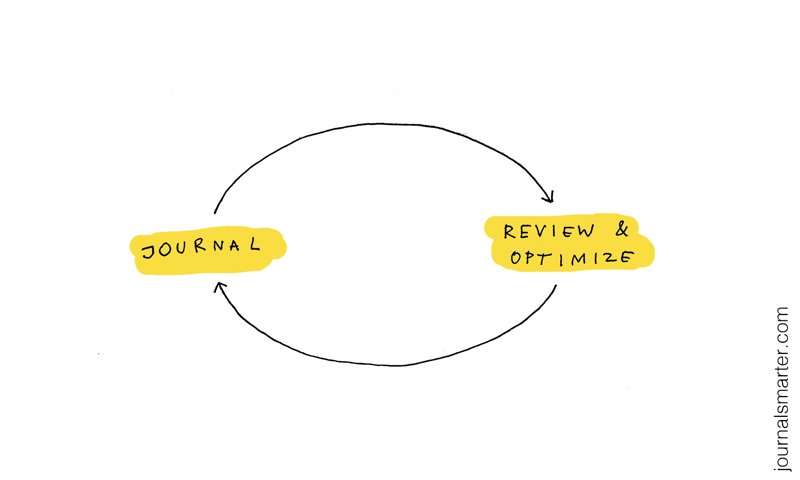
1. Journal Every Day
That’s the most important thing: create space in your life to allow your new journaling practice to bring you the benefits you desire.
Reflect on how much time can you dedicate to journaling, and when that will happen (the more you define a habit, the more likely you are to keep it).
For example: 30 minutes in the morning and 15 minutes before sleep. Any amount of time will do (even 10 minutes).

Once you have that figured out, simply start journaling. You don’t need anything apart from a pen, a journal (any notebook will do) and the four journaling principles you already know:
- Let your mind flow
- Paper will take anything
- Systems beat willpower
- Ask big questions
2. Review & Optimize
It might be obvious, but I’ll say it anyway:
To make the best out of your journal, you need to actually look through what you wrote.
Set aside some time at regular intervals (for example, 30 minutes every week) to simply flip through your journal and reflect on your insights and adjust the course of your life.
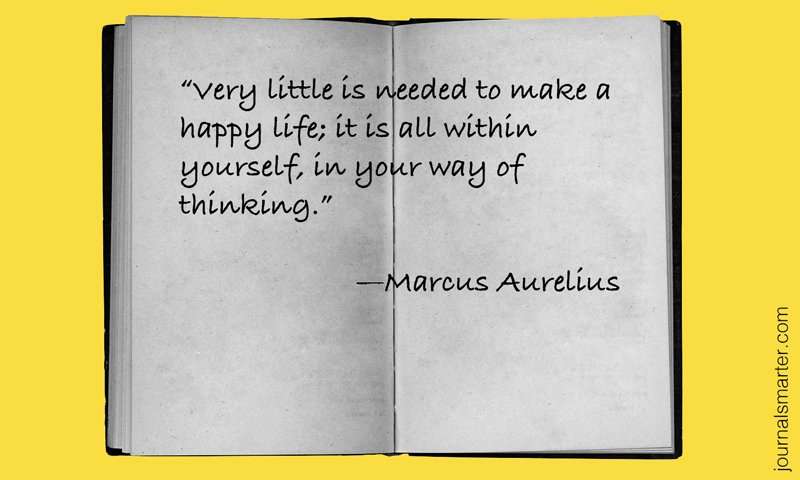
Reviewing what you wrote will give you a chance to constantly perfect and adapt your practice. After reviewing your recently used journaling tools, ask yourself:
How could I improve my journaling practice so it’s even more effective and in alignment with my needs?
Then, make any changes you see fit: modify the design, combine several tools into one, adjust your journaling routine… Whatever makes it better for you.
Remember:
Better journaling leads to better insights. Better insights lead to better actions. Better actions lead to a better life.
That’s why journaling is a game worth playing intelligently.
Frequently Asked Questions
Should I use a digital or analog journal?
Both analog and digital journaling have benefits and it really depends on which one you prefer.
Personally, I love analog journaling. Here are the reasons (which paradoxically lots of people consider as disadvantages):
- it’s uneditable (which keeps me accountable to what I’ve written);
- it’s limited with space (which forces me to filter what’s important);
- It’s slower (which puts me in a meditative state and sharpens my focus).
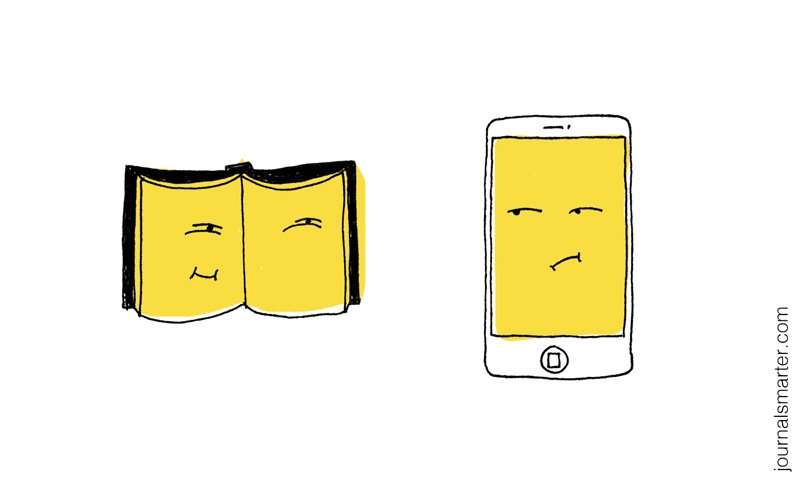
However, the biggest reason is that paper journaling is an off-screen activity, which to me is a huge advantage since it cuts down the time I’m spending in front of my devices.
Finally, it feels much easier to customize my journaling systems and design on paper. Also, there are no bugs to fix and no ads to block.
On the other hand, digital journaling comes with the advantage of keyword-based search, cool templates, and automatically calculating data that can be used to generate stats, graphs, and reports. That’s absolutely awesome, and if you can’t live without those features, then digital journaling is for you.
I’ve included some of my favorite journaling apps in the resources at the end of this article.
How to journal for a specific goal?
Use what I call the “Focus Funnel”. It’s super simple and it works like a charm:
- Write down your goal.
- If it feels too overwhelming, break it down into milestones and define the closest one.
- Define up to three High Impact Actions, which will bring you to your goal/milestone.
- Engage in all of them every day (habits are key) and track your performance.
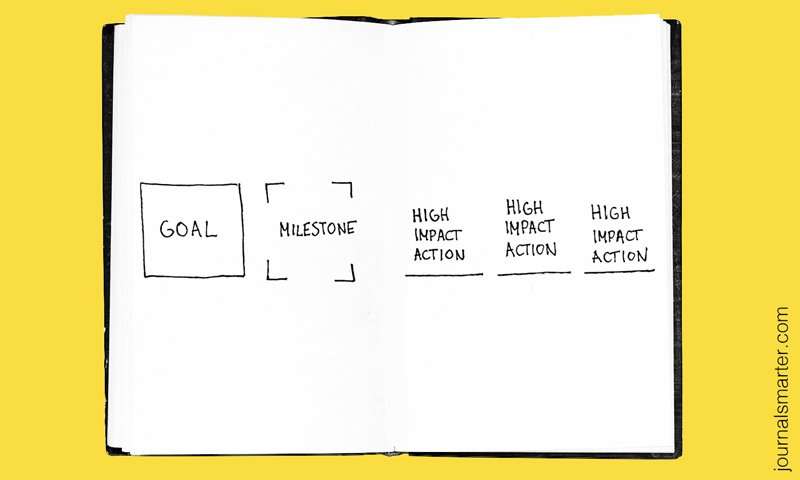
Here’s the article that will guide you through the process. And this article will show you how to stay focused without getting derailed.
What’s the difference between a diary, a journal, and a bullet journal (and which one should I pick)?
Let’s get technical.
A diary is a written record of events in your life, while a journal can also contain your thoughts, insights, observations, goals and much, much more.
Most commonly, journaling is a text-based practice, however, there’s nothing to stop you from using drawings, stickers, complex graphs, and whatever else floats your boat.
Bullet Journaling (BuJo) is a journaling method created by Ryder Caroll, which uses bullet points as the core structure. Here’s a very clear overview of bullet journaling. You can also look at #bujo on Instagram to get the idea.
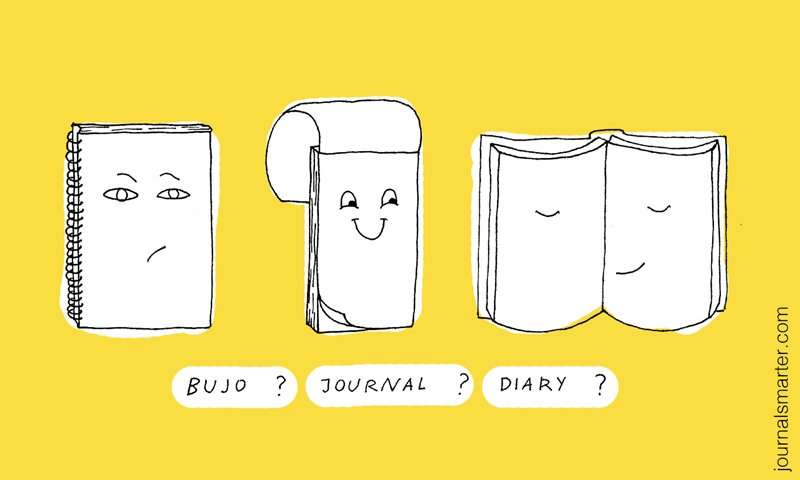
Ok, I get it. Which one should I pick?
To be perfectly honest, it doesn’t really matter.
Wait, what?
Well, all three can overlap and enrich each other. In fact, my own journaling practice started as a diary and kept evolving until today, when it combines the elements of all three.
With that in mind, pick whichever practice you feel most attracted to and keep optimizing it until it’s fully in alignment with you.
What is the best notebook for journaling?
This is a highly subjective opinion, but for both my partner and me there is no match to Leuchtturm1917 A5 with blank pages.
Why blank pages?
Because they are the least restrictive.
My handwriting is terrible and I can’t draw. Any help?
Sure. Just look at my drawing skills:
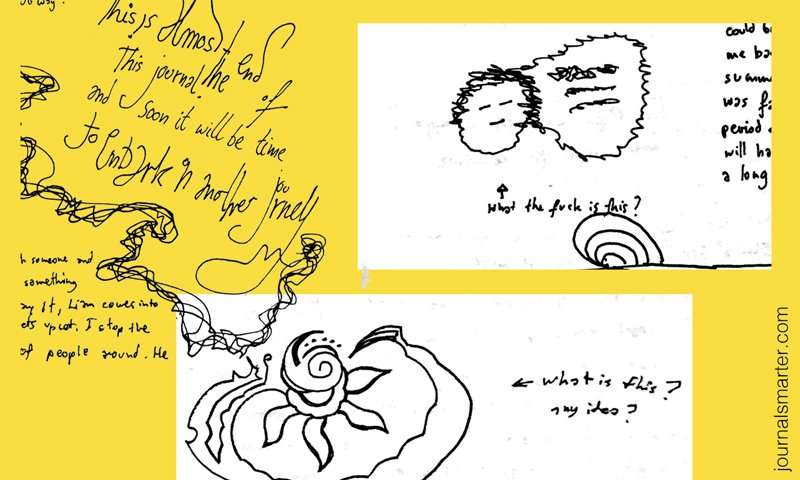
Remember: It really doesn’t matter if you can’t draw. If you feel like it, then do it. It’s your journal. You don’t need to showcase it on Instagram.
However, it might help to make sure you can understand what you wrote, unless the whole point is to never come back to it.
How do I write my first journaling entry?
Just… open the journal and start writing?
I’m kidding. But seriously, how about writing the date and the number of the current day in your life (you can calculate it here)? You’ll get a bigger picture straight away and perhaps some ideas to journal about.
You can also answer the following questions:
(If it’s morning)
How can I make today absolutely amazing?
(If it’s evening)
What would my future self want to remember from today?
Another idea is to reflect on:
- How you feel right now (feelings and needs vocabulary might be helpful).
- The most meaningful interactions you’ve had.
- What makes you feel really alive.
The Final Piece To Make It All Work
A tricky question for you:
Do you remember the necessary ingredients for mastering any skill?
Here they are:
- Know the principles
- Avoid the pitfalls
- Learn from the masters
- Have a strategy
But there’s actually one more component, without which none of the above matter.
And deep down you know exactly what it is:
It’s taking the first step.
No guide (no matter how ultimate) can do that for you.
So start journaling today, review it regularly and optimize your practice with all you have learned today. You can totally do this.
And if you ever run into a wall, or feel like you could benefit from asking a few questions, then simply drop me a message. I get back to everyone.
Resources
The last thing to do is to browse through resources.
Even More Journaling Tools
- 41 Powerful Journaling Exercises for Mind Expansion and Effective Behavior Change by Michal Korzonek
- How To Clear Your Busy Mind With a Brain Dump (+ Bullet Journal Brain Dump Examples) by Silvia Bastos
- Cognitive Journaling: A Systematic Method to Overcome Negative Beliefs by Richard Ragnarson
- Replace Your To-Do List With Interstitial Journaling To Increase Productivity by Tony Stubblebine
- Minimalist Journaling: A Fun and Effective Tool for Tremendous Habit Change by Michal Korzonek
- The 5-Bullet-Log: A Note-Taking System to Increase Self-Awareness and Learn More From Life by Silvia Bastos
- U-Journaling Practice by Otto Scharmer
- The Ultimate Guide for Learning to Art Journal by Cathy Hutchison
- Why Asking Deep Questions In The Evening Might Hold the Key To Your Problems by Silvia Bastos
- How To Write In Your Journal To Improve Yourself and Achieve Your Goals by Benjamin Hardy
- 10 Tips for Mindful Writing and Meditative Journaling by S.J. Scott
- Dream Journaling: The Ultimate Guide to Unlock Your Hidden Creativity by Silvia Bastos
- How to Finally Stop Procrastinating With 1 Simple Journaling Methodology by Michal Korzonek
- Journaling Techniques to Master Balance and Grow Faster by Silvia Bastos
- How to Create Sketchnotes (with no artistic ability at all) by Cathy Hutchison
Amazing Articles about Journaling
- Benefits of a daily diary and topic journals by Derek Sivers
- What My Morning Journal Looks Like by Tim Ferriss
- How These 14 Incredible People Use Their Journal to Stay On Top of Their Game by Silvia Bastos
- This Is The Most Important Thing You Can Do Each Morning by Ryan Holiday
- The Astonishing History of Journaling by Michele Swensen
- Keeping a Diary in China: Memories for the Future by Sang Ye
- History of Journaling by Inbreathe
- 8 famous visionaries who kept a journal by Michael d’Estries
- The Power of the Pen: How to Boost Happiness, Health, and Productivity by Adam Grant
- 11 Journaling Tips For People Who Are Absolutely Terrible At Keeping A Journal by Charlotte Ahlin
- I Tried Bullet Journaling To See What The Hype Is Actually About by Jasmin Nahar
- The Benefits of Journaling for Stress Management by Elizabeth Scott
- Why Journaling Makes Better Leaders by Bruce Rhoades
- Advanced Journaling by Matt Pierson
Journaling Apps
- Jour (iOS)
- Stoic App (iOS)
- Journey (iOS, Android, macOS, Windows, Linux)
- Evernote (iOS, Android, macOS, Windows)
- Paper (iOS)
- Bear (iOS)
- Mood Notes (iOS)
- Momento {:target=”_blank”}(iOS)
- Glimpses (Windows for now. iOS and Android in development)
- Day One App (iOS, Android, macOS)
And if you want some more:
- The 10 Best Journaling Apps for 2019by Melanie Pinola
- The 14 Best Mood Tracker Apps for 2019 by S.J. Scott
Journaling Videos You Could Watch
How to Journal for Self-Growth
How to Journal Every Day for Increased Productivity, Clarity, and Mental Health
The Journaling Exercise That Can Change Your Life
Why Interstitial Journaling is the cutting edge of mindfulness